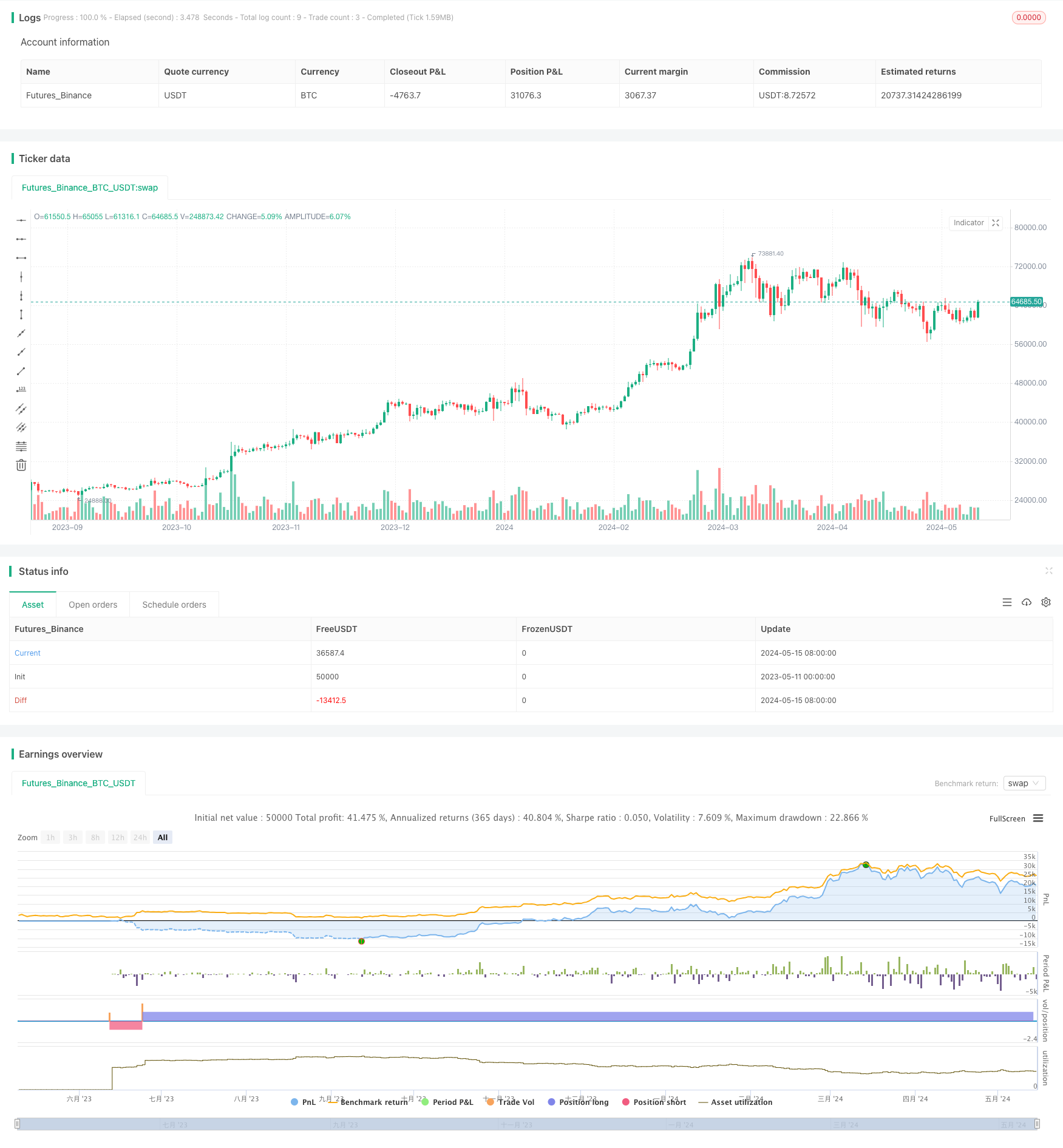基于RSI、ADX和一目均衡图的多因子趋势跟踪量化交易策略
Author: ChaoZhang, Date: 2024-05-17 13:37:47Tags: RSIADXICHIMOKUSMA

概述
该策略通过结合相对强弱指数(RSI)、平均方向指数(ADX)和一目均衡图(Ichimoku Cloud)三个技术指标,构建了一个多因子趋势跟踪量化交易策略。策略的主要思路是利用RSI指标判断市场超买超卖情况,ADX指标判断趋势强度,一目均衡图判断趋势方向,并结合移动平均线的交叉信号,在满足特定条件时开仓做多或做空。
策略原理
- ADX指标:当ADX值大于20时,表明市场处于强趋势中。
- RSI指标:RSI衡量一段时间内价格的相对强度,用于识别超买或超卖情况。
- 一目均衡图:价格相对于云层的位置提供趋势方向的信息。
- 开多仓条件:当价格在一目均衡云上方,14周期SMA上穿28周期SMA,且RSI值低于其移动平均线时,开多仓。
- 开空仓条件:当价格在一目均衡云下方,14周期SMA下穿28周期SMA,且RSI值高于其移动平均线时,开空仓。
策略优势
- 多因子结合:该策略综合考虑了趋势强度、超买超卖情况和趋势方向等多个因素,信号更加可靠。
- 趋势跟踪:通过一目均衡图和移动平均线的配合,策略能够有效捕捉并跟踪市场趋势。
- 风险控制:RSI指标的引入有助于避免在超买超卖区买卖,降低风险。
策略风险
- 参数优化风险:该策略包含多个参数,如RSI周期、ADX周期、一目均衡图周期等,不同参数的选择可能导致策略表现差异较大,需要对参数进行优化。
- 市场风险:在趋势不明朗或市场波动剧烈的情况下,该策略可能会出现较多的假信号,导致频繁交易和资金损失。
- 滑点和交易成本:频繁的开仓平仓可能会增加滑点和交易成本,影响策略收益。
策略优化方向
- 参数优化:对策略中的各项参数进行优化,如RSI周期、ADX周期、一目均衡图周期、移动平均线周期等,以提高策略的稳定性和收益性。
- 止损止盈:引入合理的止损止盈机制,如根据ATR设置动态止损,以控制单笔交易的风险。
- 仓位管理:根据市场波动性和账户风险承受能力,动态调整仓位大小,以控制整体风险。
- 多周期和多品种:将该策略应用于不同的时间周期和交易品种,分散风险,提高策略的适应性。
总结
该策略通过创新性地结合RSI、ADX和一目均衡图三个技术指标,构建了一个多因子趋势跟踪量化交易策略。策略在趋势跟踪和风险控制方面具有一定优势,但同时也存在参数优化、市场风险和交易成本等风险。未来可以通过参数优化、止损止盈、仓位管理和多周期多品种应用等方式对策略进行优化,以提高其稳定性和盈利能力。
/*backtest
start: 2023-05-11 00:00:00
end: 2024-05-16 00:00:00
period: 1d
basePeriod: 1h
exchanges: [{"eid":"Futures_Binance","currency":"BTC_USDT"}]
*/
//@version=5
strategy("Stratejim RSI, ADX ve Ichimoku ile", overlay=true, margin_long=100, margin_short=100)
// ADX, RSI ve Ichimoku tanımları
[diPlus, diMinus, adx] = ta.dmi(14, 14)
rsiPeriod = 14
rsi = ta.rsi(close, rsiPeriod)
tenkanPeriod = 9
kijunPeriod = 26
senkouSpanBPeriod = 52
displacement = 26
tenkan = ta.sma((high + low) / 2, tenkanPeriod)
kijun = ta.sma((high + low) / 2, kijunPeriod)
senkouSpanA = (tenkan + kijun) / 2
senkouSpanB = ta.sma((high + low) / 2, senkouSpanBPeriod)
// Ichimoku Bulutu koşulları
priceAboveCloud = close > ta.valuewhen(bar_index, math.max(senkouSpanA, senkouSpanB), displacement)
priceBelowCloud = close < ta.valuewhen(bar_index, math.min(senkouSpanA, senkouSpanB), displacement)
// Uzun pozisyon için koşullar
longSmaCondition = ta.crossover(ta.sma(close, 14), ta.sma(close, 28))
longAdxCondition = adx > 20
longRsiCondition = rsi < ta.sma(rsi, rsiPeriod)
if (longSmaCondition and longAdxCondition and not longRsiCondition and priceAboveCloud)
strategy.entry("My Long Entry Id", strategy.long)
// Kısa pozisyon için koşullar
shortSmaCondition = ta.crossunder(ta.sma(close, 14), ta.sma(close, 28))
shortAdxCondition = adx > 20
shortRsiCondition = rsi > ta.sma(rsi, rsiPeriod)
if (shortSmaCondition and shortAdxCondition and not shortRsiCondition and priceBelowCloud)
strategy.entry("My Short Entry Id", strategy.short)
相关内容
- 多指标交叉动态动量策略
- 改进型双重 EMA 回撤突破交易策略
- 动态头寸规模短线外汇交易策略
- 动态趋势追踪策略 - 多指标综合动量分析系统
- Scalping EMA ADX RSI with Buy/Sell
- 多周期技术指标动态交易系统策略
- 多指标动态止损动量趋势交易策略
- 多重滤网趋势突破智能均线交易策略
- 交易量动态调整DCA策略
- 艾略特波浪理论4-9脉冲波自动检测交易策略
更多内容
- EMA5与EMA13交叉策略
- EMA SAR 中长期趋势跟踪策略
- 逆向波动率突破策略
- Nifty50三分钟开盘价突破策略
- 布林带动态止损止盈策略
- 改进型多空转换K线形态突破策略
- Laguerre RSI与ADX滤波交易信号策略
- 价量突破买入策略
- K线连续数目牛熊判断策略
- 超级均线与Upperband交叉策略
- RSI与MACD结合的多空策略
- 一云多均线交易策略
- 威廉鳄鱼均线趋势捕捉策略
- 动态MACD和一目均衡图交易策略
- 基于平均方向指数过滤器的均线拒绝策略
- Bollinger Bands 布林带策略:精准交易,实现最大收益
- ATR均线突破策略
- KNN 机器学习策略:基于 K 近邻算法的趋势预测交易系统
- CCI+RSI+KC趋势滤波多空双向交易策略
- BMSB 突破策略